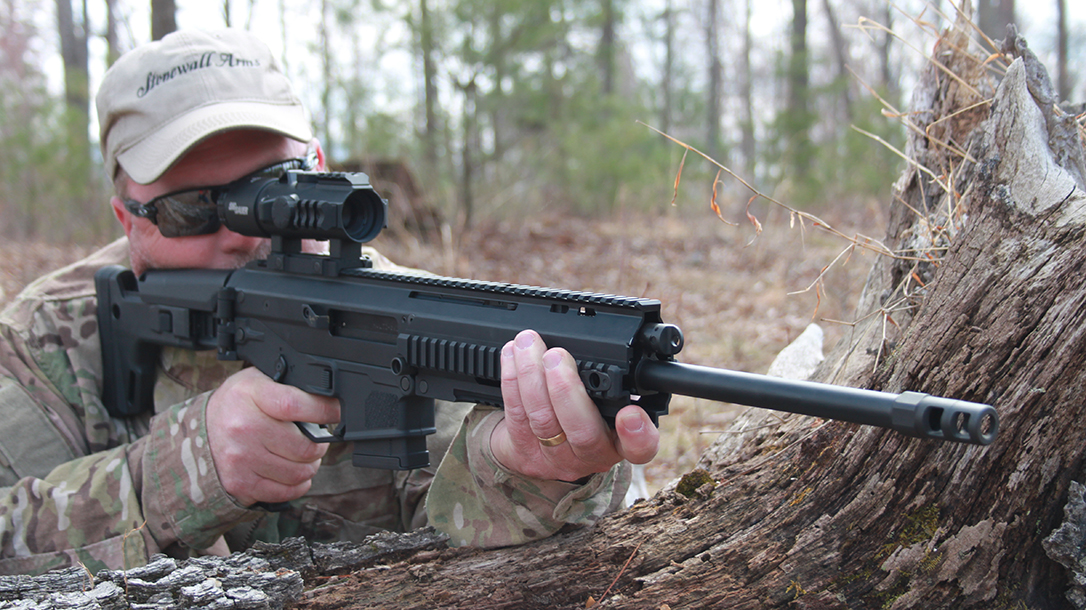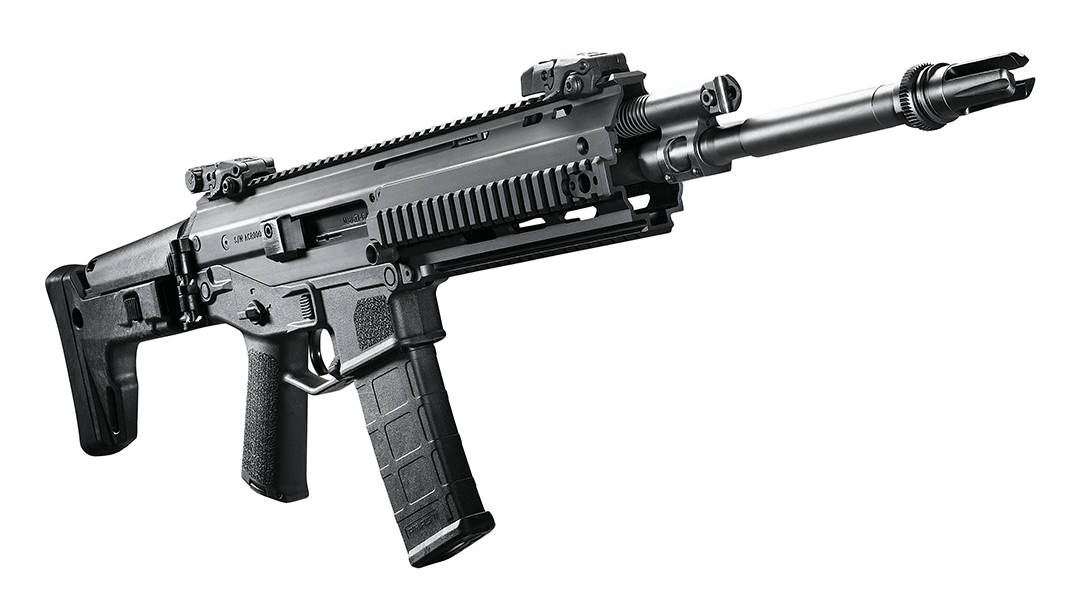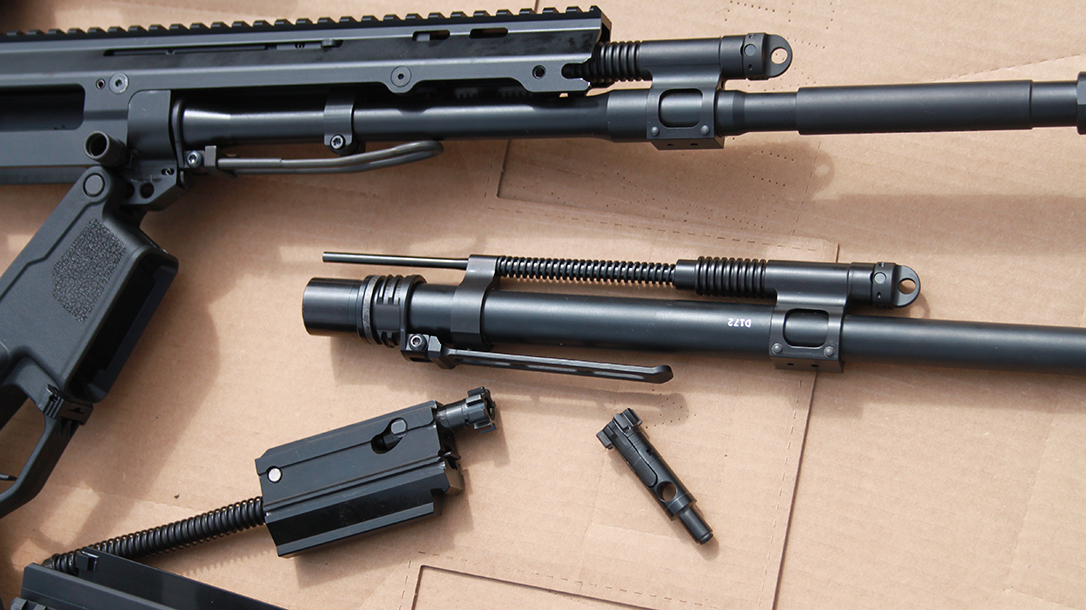Finally arriving on dealer shelves in quantity is the Bushmaster Adaptive Combat Rifle (ACR) along with caliber conversion kits. Say it ain’t so! Why the sarcasm? Because civilians have been hearing about this since 2010 with little actually happening when it comes to the ACR. Well, times are a-changin’ in the Big Green universe with its various brands seeking to reclaim market share.
Bushmaster is part of the Remington Outdoor Company, which emerged from a short-lived bankruptcy and has a new leadership team focused on addressing previous shortcomings. Frankly, Remington lost its way when it failed in listening to customers and supposed it could dictate desire. This approach obviously proved flawed and resulted in difficulties leading to bankruptcy.
Advertisement — Continue Reading Below
Now there’s a new way of doing business at Remington that takes a dealer-centric approach combined with pooling the strengths of both the Defense and Commercial divisions to reinforce each other. This allows for a more flexible focus and a healthier company overall. Brands like Advanced Armament Corporation (AAC), DPMS, Bushmaster and Barnes will be maximized for a more horizontal approach to the firearms/outdoor market, sharing the responsibility of providing quality ammunition, sporting rifles and shotguns, handguns, precision rifles, tactical shotguns, suppressors and so forth. The ACR is just one product getting this boost.
AR Alternative
It’s no secret that the AR is the best-selling civilian and law enforcement rifle in the U.S., and it’s incredibly popular around the world, too. But the early 2000s saw several manufacturers and designers attempt to move past the classic direct-impingement operating system of the AR, and Bushmaster’s ACR arrived in 2010. It was spawned from the Magpul Masada, which was unveiled at the 2007 SHOT Show.
Magpul engineered the Masada based on elements from a series of other designs, including the AR-15, AR-18, FN SCAR and Heckler & Koch G36. Magpul’s foresight included an adjustable short-stroke gas piston operating system and modularity in terms of barrels, caliber and furniture. But Magpul eventually realized that it did not have the resources to produce and market the firearm in the fashion it deserved, so it licensed the design to Bushmaster in 2008.
Advertisement — Continue Reading Below
Bushmaster renamed the rifle the ACR, and with the expertise and manufacturing power of Remington as a partner, all things looked promising. Bushmaster handled civilian ACR sales while Remington focused on military and federal law enforcement procurement. Due to space limitations, we’ll wrap up by saying that not everything went smoothly with the ACR, which is just now showing up with caliber conversion kits after nearly 10 years on the market.
Hybrid Warrior
While the ACR has been available to civilians in 5.56mm NATO, Bushmaster recently decided to expand its potential by offering 6.8 SPC and .450 Bushmaster conversion kits. To that end, I recently received an ACR Enhanced for testing with both 5.56mm NATO and .450 Bushmaster kits. By why the latter?
The .450 Bushmaster came about because shooters wanted a little more oomph than a .22-caliber round could provide, but still in an AR-15-sized package. Bushmaster asked Hornady to create a .45-caliber cartridge that would still work in an AR-15 action, and the rest is history. The .450 Bushmaster is based on a shortened rimless, straight-walled .284 Winchester case that is 1.7 inches long. It has a rebated 0.473-inch-diameter rim and a 0.5-inch-diameter head. It also uses 0.452-inch-diameter bullets like .45-caliber handguns, not 0.458-inch-diameter rifle bullets. The loaded overall cartridge length is 2.25 inches, and the case takes small rifle primers.
Advertisement — Continue Reading Below
Typical bullet weights range from 250 grains up to 300 grains, and Hornady and Remington offer several loadings for customers today. Buffalo Bore offers a potent 360-grain, hard-cast load along with multiple other bullet weights and types—not a surprise to anyone familiar with Buffalo Bore’s innovative product lines.
In short, the .450 Bushmaster was specifically designed to generate unprecedented stopping power at short to moderate ranges from an AR. For 250- to 300-grain .450 Bushmaster loads, a 175-yard zero will give a relatively flat trajectory out to 200 yards. The .450 Bushmaster’s heavy, large-diameter bullets and moderate velocities make it well suited for use in multiple roles, including hunting, law enforcement and personal defense. The round’s terminal ballistics and large projectile have equal effects on engine blocks and large hogs, assailants with body armor or front windshields. It’ll pass through automotive body panels as easily as deer cavities.
Modular Machine
As mentioned, the Bushmaster ACR operates via a short-stroke gas piston system, which has an advantage in that the heat and fouling produced during the firing process are not routed into the bolt or chamber, keeping these critical areas cooler and cleaner for greater reliability—especially now with the increasing use of suppressors. The ACR also features an adjustable gas regulator, with the first position for normal operation and the second for use with a sound suppressor. The platform was designed from the beginning to accommodate suppressor use, and an AAC flash suppressor comes standard.
Advertisement — Continue Reading Below
The ACR uses a non-reciprocating charging handle that can be moved to either side of the receiver. An ambidextrous handle is also available. The mechanical advantage of the charging handle helps ensure that the multi-lug bolt seats consistently into battery. The location of the charging handle isn’t as far forward as other similar rifles, leaving plenty of space on the forend for your hand or accessories.
Because there are no AR buffer springs, multiple buttstock options are available, including fixed, folding and precision styles. All are adjustable for length of pull and cheek height. Forends can be had in either polymer or aluminum. The controls are all ambidextrous.
The Bushmaster ACR Enhanced Caliber Swap
But what really garners the most attention is how easy it is to swap out barrels and calibers. No tools are needed beyond a handy bullet to push out pins to hinge open the receivers and remove the handguard. By removing the handguard, the underside of the barrel is exposed. To change the barrel, lock the bolt to the rear, pull down on the integral, hinged barrel wrench and rotate the barrel wrench nut lever one-quarter turn to the left. Then, unseat the barrel nut from the trunnion by pulling forward on the barrel wrench. The barrel assembly and the attached gas system assembly can then be removed.
Advertisement — Continue Reading Below
Reverse the process to install the new barrel. A barrel nut with interrupted threads locks the barrel assembly into the ACR’s steel trunnion, fixed to the upper receiver by way of two roll pins and two machine screws. Moving between calibers requires bolt head and magazine alterations as well.
Hands On
To test the ACR on the range, I installed a Sig Sauer 3x24mm BRAVO3 battle sight. This fixed 3X optic features an illuminated horseshoe-dot reticle and a 42-percent wider field of view compared to current sights. The BRAVO3 takes advantage of low-dispersion (LD) glass and an aspherical lens design for edge-to-edge distortion-free viewing. Short top and side rails allows you to add lasers or infrared designators. And thanks to the BRAVO3’s 3X magnification, the ACR should be able to handle a variety of shooting scenarios, such as CQB or distant engagements, with equal aplomb no matter the caliber.
I used a variety of ammo to test the ACR, including multiple 5.56mm/.223 loads from Remington and Federal as well as .450 Bushmaster ammunition sourced from Hornady, Remington and Buffalo Bore. None of the loads I tested were wider than 2.5 inches at 100 yards. However, that said, my groups didn’t shrink much below 1.5 inches, even if I used premium rounds. Just remember that the ACR is a fighting rifle, not a target rifle.
Advertisement — Continue Reading Below
I spent several magazines’ worth of ammunition engaging plate racks and man-sized steel targets with the ACR. My drills quickly moved past stand-and-deliver types when I decided to concentrate on using the ACR in training scenarios involving team tactics and patrolling, and to do so, I utilized the Echo Valley Training Center’s 360, HESCO Shoot House and “Jungle Walk” ranges. Here the ACR to shine in terms of firepower, handling characteristics and combat accuracy. I also switched between calibers to test the ACR’s modularity throughout the evaluation.
Final Thoughts
It wasn’t hard to discern .450 Bushmaster recoil and muzzle blast from 5.56mm. But the steel targets told the same story, rocking back vigorously when impacted by 300-grain bullets. Firing from unorthodox positions while working around obstacles and range vehicles showed the ACR’s potential in tight dynamic settings. While the 5.56mm isn’t known for its recoil, after years of firing AR-pattern rifles, the ACR’s impulse is decidedly different in a positive way. Smoother and subtler are two descriptions that come to mind.
Advertisement — Continue Reading Below
While the ACR is unlikely to unseat the AR here in the U.S., it’s nice to experience another take on how to best send 5.56mm rounds downrange. The ACR offers users a chance to own a rifle different than all the ARs and AKs so common today. The ability to change calibers is an added enticement for those so inclined. Law enforcement agencies with progressive procurement policies could easily consider using the ACR, not to mention private contractors and security-conscious civilians. This is a positive reflection on the rifle’s reliability, handling and ergonomics.
For more information, visit bushmaster.com.
Bushmaster ACR Enhanced Specifications
- Caliber: 5.56mm NATO, .450 Bushmaster
- Barrel: 16.5 inches
- Overall Length: 36.75 inches
- Overall Weight: 8.2 pounds (empty)
- Stock: Folding, adjustable
- Sights: None
- Action: Piston-operated semi-auto
- Finish: Matte black
- Overall Capacity: 30+1 (5.56mm), 13+1 (.450)
- MSRP: $2,948 (as tested)
Bushmaster ACR Enhanced Performance
5.56mm/.223: Velocity, Accuracy
Advertisement — Continue Reading Below
- Barnes 55 TSX: 2,920, 1.50
- Federal 62 American Eagle FMJ: 3,005, 1.75
- Remington 55 FMJ: 3,050, 1.30
- Sig Sauer 77 OTM: 2,630, 1.25
.450 Bushmaster: Velocity, Accuracy
- Buffalo Bore 360 Hard-Cast: 1,625, 2.00
- Hornady 250 Black FTX: 2,105, 1.75
- Remington 260 AccuTip: 2,010, 2.33
Bullet weight measured in grains, velocity in fps by chronograph and accuracy in inches for best five-shot groups at 100 yards.
This article is from the August-September 2019 issue of Tactical Life magazine. Grab your copy at OutdoorGroupStore.com. For digital editions, visit Amazon.

























